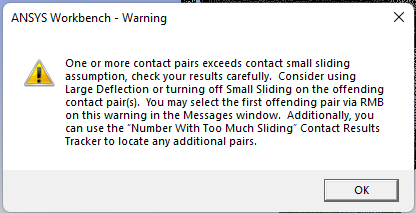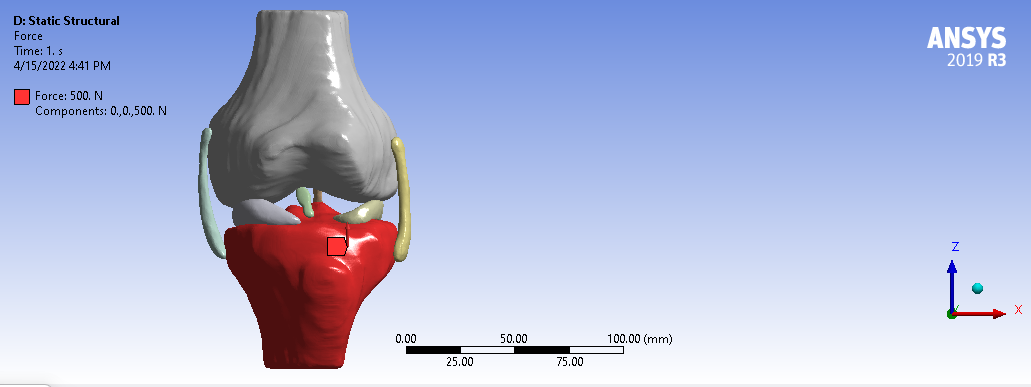-
-
March 23, 2022 at 10:54 am
OmidNazeri1997
SubscriberGreetings and Regards,
I am interested in the human knee joint simulation field. Recently, I have investigated an article about this, in which all the simulation details are clear. The researchers have used the ANSYS software in order to determine the stresses in the human ACL (Anterior Cruciate Ligament).
Here is the article link:
“Numerical Analysis of the ACL, with Sprains of Different Degrees
after Trauma” (https://www.hindawi.com/journals/cmmm/2021/2109348/)
Actually, I have tried to accurately pass all of the required steps for the simulation such as, material properties, the meshing method, the contact problems, the specified force and etc.
But, the trouble I have encountered, is the difference between the simulation results. I mean, the reported stress values in the reference article are different from the values I have acquired.
Of course, there should be 2 “frictionless” contacts according to the reference article. But, I cannot finish up the simulation process successfully, considering this type of contact (frictionless). I mean, by using these contacts, the software couldn’t converge the problem and finish up the solution. The only way for me to carry out this simulation was to use “bonded” contacts. But, the results are different in order.
Do you know what could be the problem?
I was wondering if you could help me with this.
March 24, 2022 at 12:22 pmSaumadeep Choudhury
Forum Moderator
You correctly pointed out that the difference in results obtained is due to the use of bonded contacts in place of frictionless contact.
Most convergence issues arising in a problem involving contacts are due to ill-posed boundary conditions. Check if that is an issue in your case.
Also, please send screenshots of the error message you see when using frictionless contacts so we can better understand your issue.
Regards, Saumadeep
Ansys Help
Ansys Learning Forum (Rules & Guidelines)
March 25, 2022 at 1:28 pmOmidNazeri1997
Subscriberthank you for your help.
As mentioned in the reference article, I used the same B.C. for the femur, Fixed Support.
Actually, I don't get any error message. But, the software keeps working on the "preparing and solving the mathematical model" status over and over again.
I don't know what exactly is the problem.
April 15, 2022 at 12:18 pmJune 24, 2022 at 7:31 amOmidNazeri1997
SubscriberHi everyone. Finally, I've solved the issue of the solution convergence, considering these conditions:
1) Increasing the size of meshing elements to reduce the solution time.
2) Imposing a "frictionless support" for the tibial face, because of the frictionless contact.
But, still there is a little difference between the stress values compared to the reference article. I mean, the acquired values for the stress distribution are about 10 times greater than the reported values from the paper.
Can anyone explain what could be the issue???
June 24, 2022 at 7:35 amOmidNazeri1997
SubscriberCould small geometry differences be the problem? or meshing methods?
August 3, 2022 at 12:59 pmSaumadeep Choudhury
Forum ModeratorHi, Answers to this discussion can be found in this post:
Knee Joint Simulation (NEW) (ansys.com)Viewing 6 reply threads- The topic ‘Knee joint simulation’ is closed to new replies.
Ansys Innovation SpaceTrending discussionsTop Contributors-
3597
-
1283
-
1107
-
1068
-
983
Top Rated Tags© 2025 Copyright ANSYS, Inc. All rights reserved.
Ansys does not support the usage of unauthorized Ansys software. Please visit www.ansys.com to obtain an official distribution.
-


Ansys Assistant

Welcome to Ansys Assistant!
An AI-based virtual assistant for active Ansys Academic Customers. Please login using your university issued email address.
Hey there, you are quite inquisitive! You have hit your hourly question limit. Please retry after '10' minutes. For questions, please reach out to ansyslearn@ansys.com.
RETRY









